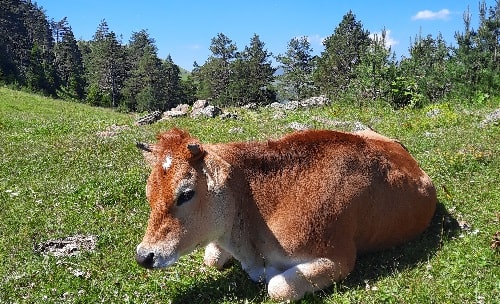Which type of vegetation dominates Switzerland?

A state located in Central Europe. It is bordered by Germany to the north, Austria and Liechtenstein to the east, Italy to the south, and France to the west. It is a confederation of 25 states. Switzerland is the most mountainous country in Europe. 3/4 of the land is covered with mountains. The Jura Mountains, which run along the border with northwestern France, are separated from the Alps covering the southern part of the country by the Mitteland plateau. The Swiss Alps include its central part, stretching from Mont-Blanc to the Ortler. The highest peaks are Mente Rosa and Matterhorn (4478 m) in the Pennine Alps. The highest peaks in the Bernese Alps are Finsteraarrhorn (4274 m) and Jungfrau (4166 m)
What are the climate characteristics of Switzerland?
The climate of Switzerland is very different. Although the weather is dry and clear in the Rhetian Alps, a humid temperature prevails in the Canton of Ticino, and a Mediterranean climate prevails in Lakes Magiore and Lugarna. The high peaks of the mountains remain covered with snow throughout the year. The climate is generally moderate.
The Swiss high plateau is the plateau between the Alps and the Jura Mountains. This plateau is at an altitude of 1000 m. Also known as the Swiss Hills. This plateau is covered with meadows and conifer forests. Vegetation of switzerland >>
Is animal husbandry done in Switzerland?

Livestock occupies a large place in the economy in Switzerland. It is a very valuable natural resource in terms of animal husbandry, as half of its land consists of grasslands and evergreen meadows. Goats and sheep are bred in high regions. In the main livestock field, work is done to raise slaughter and dairy animals such as cattle and cows. The cheese industry is world famous. It has a worldwide say in chocolate, which is considered one of the dairy products. What is the landscape of Switzerland? >>
Switzerland has a temperate continental climate with abundant rainfall. Climatic conditions vary from canton to canton, and the frequency of rainy days and sunny days varies during the season. Sudden weather changes are common in any season.
It is characterized by frequent snowfalls in the winter period. The average temperature in Switzerland in July and August ranges from 18°C to 28°C, while in January and February the average temperature ranges from -2°C to 7°C.
The average temperature in Switzerland during the spring and autumn months ranges from 8°C to 15°C. Temperatures, on the other hand, can vary greatly depending on altitude.
What is the vegetation in the Swiss Alps?
The vegetation in the Swiss Alps varies with altitude, aspect (the direction the slope faces), and local conditions. Here is a general overview of the vegetation zones in the Swiss Alps:

- Subalpine Zone (1,200 to 2,000 meters): In the lower slopes, you’ll find forests dominated by coniferous trees such as spruce (Picea abies), fir (Abies alba), and Swiss stone pine (Pinus cembra). Understory vegetation may include shrubs like alpenrose (Rhododendron ferrugineum) and bilberry (Vaccinium myrtillus).
- Montane Zone (2,000 to 2,500 meters): As you ascend, the forests transition to mixed forests of conifers and broadleaf trees. Common tree species include spruce, larch (Larix decidua), Swiss stone pine, and beech (Fagus sylvatica). This zone also supports various wildflowers and alpine meadows.
- Subalpine Meadow Zone (2,500 to 3,000 meters): Above the tree line, subalpine meadows dominate the landscape. These meadows are characterized by a diverse array of grasses, herbs, and alpine flowers, including gentians (Gentiana), edelweiss (Leontopodium alpinum), and saxifrages (Saxifraga spp.).
- Alpine Zone (above 3,000 meters): In the high alpine zone, vegetation becomes sparser due to harsh conditions. You’ll find mainly low-lying alpine plants, lichens, and mosses that have adapted to the extreme alpine environment. Examples include cushion plants like alpine avens (Dryas octopetala) and dwarf willows (Salix spp.).
It’s important to note that this is a general overview, and variations can occur based on local factors such as microclimates, soil conditions, and human impacts. Additionally, protected areas, such as national parks or nature reserves in the Swiss Alps, can have unique and diverse vegetation due to conservation efforts.





